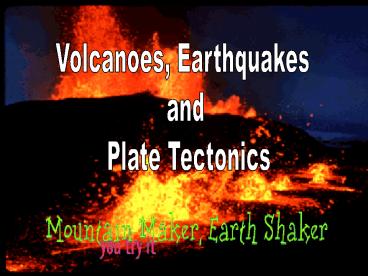Volcanoes, Earthquakes - PowerPoint PPT Presentation
1 / 36
Title:
Volcanoes, Earthquakes
Description:
Title: PowerPoint Presentation Author: Sarah Black Last modified by: Sarah Black Created Date: 6/17/2004 6:56:36 PM Document presentation format: On-screen Show – PowerPoint PPT presentation
Number of Views:232
Avg rating:3.0/5.0
Title: Volcanoes, Earthquakes
1
Volcanoes, Earthquakes and Plate Tectonics
2
1. WHY?
Do earthquakes and volcanoes happen?
3
Because of...
4
SO WHAT IS TECTONICS AND HOW DOES IT CAUSE
EARTHQUAKES AND VOLCANOES?
WHY DO THEY HAPPEN?
5
To understand plate tectonics first you need to
know about.
The Structure of the Earth.....
By understanding the structure of the earth and
what goes under our feet we can begin to
understand why we get earthquakes and volcanoes.
6
(No Transcript)
7
A cross-section through the earth
1000 C
4000 C
7000 C
8
Plate Tectonics Scientific Definition
The earths crust is divided into plates. There
are seven large ones and many other smaller ones.
They move around, floating on the mantle and it
at the boundary where 2 of the giant plates meet
that earthquakes and volcanoes occur and where
mountains are built.
9
The Plates move because of convection currents
10
CONVECTION CURRENTS.
.work just the same as boiling up some pea soup!
11
Heat transfer from the core to the mantle
produces slow convection of the mantle material
(in the order of centimetres per year)
12
The huge plates move due to the convection
currents bubbling away underneath them
13
2. WHERE?
Do they happen then?
14
Earthquakes and volcanoes happen along the
boundaries of these plates
So where are the earth's major plate boundaries?
15
This map shows the distribution of earthquakes
and volcanoes. As you can see they are
concentrated along the plate boundaries.
16
But how do we know that these plates exist.......
There is a theory called PLATE TECTONICS that
explains the whole situation
17
(No Transcript)
18
The breaking up of a supercontinent....
Wegener said that there at first the earth was a,
gigantic supercontinent 200 million years ago,
which he named Pangaea, meaning "All-earth".
Pangaea was a supercontinent consisting of all of
Earth's land masses. It began breaking up during
the Jurassic period, forming 2 continents
Gondwanaland and Laurasia,
Pangaea started to
break up into two smaller supercontinents, called
Laurasia and Gondwanaland and eventually into
land masses that look like our modern-day
continents.
19
So it would have looked like this.......
20
And what does it look like today......
So was it just one supercontinent.....?
21
YES...and here's the evidence....
22
Anyway, back to those plates
How do they cause volcanoes to happen..There are
three types of plate movement
23
1. Constructive Plate Boundaries
On a constructive plate boundary two plates move
apart, allowing magma, or molten rock, to rise
from the Earth's interior to fill in the gap. The
two plates move away from each other like two
conveyor belts moving in opposite directions
24
2. Destructive Plate Boundaries
If 2 light continental plates collide they rise
up forming mountains and volcanoes
If a heavy oceanic plate and a light continental
plate collide the heavy one sinks also causing
volcanoes and mountains to form.
25
3. Conservative Boundaries
A transform boundary occurs where two plates
slide against each other. But rather than sliding
smoothly, the plates build up tension, then
release the tension with a spurt of movement.
This movement is felt as an earthquake
26
(No Transcript)
27
(No Transcript)
28
(No Transcript)
29
(No Transcript)
30
So what do these volcanoes look like....
31
(No Transcript)
32
(No Transcript)
33
(No Transcript)
34
(No Transcript)
35
(No Transcript)
36
(No Transcript)































